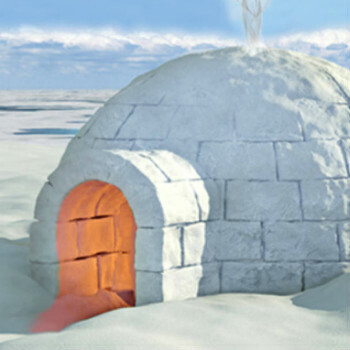igloo is a building made of snow and ice, used as shelter from the cold extreme in polar regions. Igloos are traditionally used by Eskimos, to protect themselves from low temperatures when they go hunting, for example.

According to the Inuit language, which is mainly spoken by Eskimos, igloo (igdlu, in Inuit) literally means "home".
The igloos are built from the junction of compact snow blocks, which are arranged in the shape of an ascending spiral, starting just below ground level, to prevent the entry of cold air from below.
The igloo is dome-shaped to prevent the accumulation of ice and snow on top, which could cause the structure to collapse. It is also necessary to build a small opening at the top of the igloo so that the room can be ventilated.
Eskimos often build igloos where the sea is frozen. The ice in these areas is more compact and thin, making it less cold.
Why are igloos hot inside?
The igloos do not heat the environment inside, but they can keep the heat that is emitted by bodies or bonfires, for example.
The explanation lies in the fact that (compact) snow has an extremely low thermal conduction, approximately 100 times less than aluminum. Thus, the heat formed inside remains trapped in the igloo and causes the room temperature to warm up.
With human body heat and an oil lamp, for example, the interior of the igloo can be up to 40 degrees warmer compared to the temperature outside.
The slight melting of ice (due to the use of a fire inside the igloo, for example) is also a advantage, as the water is re-frozen and causes more solid and insulating ice to form around the structure.
The compact snow packs also help to block the frigid arctic winds, increasing the thermal sensation inside the igloo.

